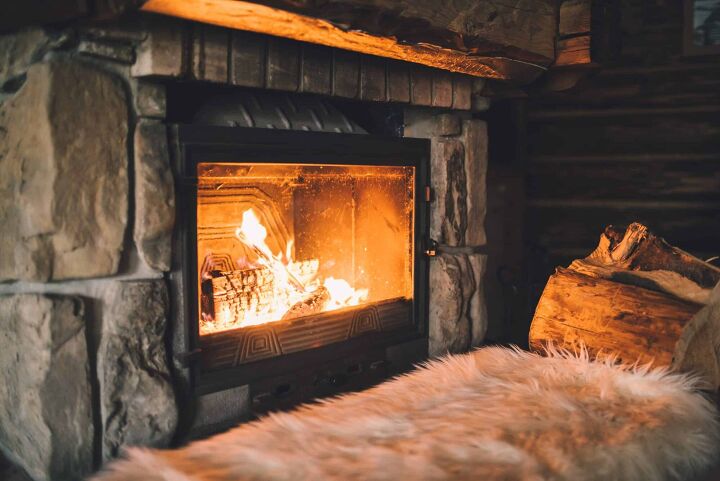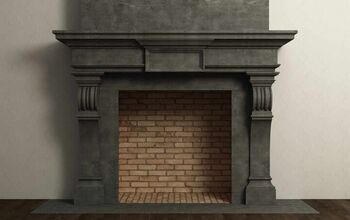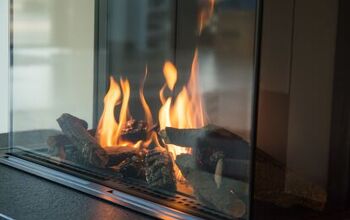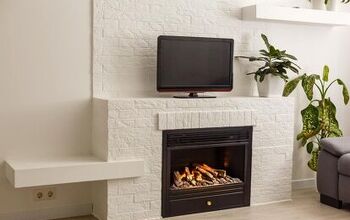How To Use A Fireplace Damper (Step-by-Step Guide)

Fireplaces are the central gathering place in most peoples’ homes. A fireplace can provide warmth, comfort, lighting, and more. Although they are relatively simple to operate, the fireplace damper can be a source of confusion for some people.
A fireplace damper helps regulate the burn rate and heat retention of a fireplace. Allowing air to enter the chimney will help start your fire and allow it to burn safely.
To use a fireplace damper, use the control knob to open the airway while starting the fire. After the fire begins to burn, partially close the damper to keep the warm air in while allowing the smoke to vent out.
A damper is useful for starting a fire, as well as fine-tuning the fire as it burns. When the fireplace is not in use, the closed damper will keep your home’s warmth from escaping through the chimney.
Some fireplace dampers can be a bit complicated to use, so read on to find out more about using these devices.
Do You Need Brick or Stone Fireplace Repair?
Get free, zero-commitment quotes from pro contractors near you.

Chimney Damper or Fireplace Damper?
There are two different types of dampers that perform the same task in different ways.
Chimney Damper
A chimney damper, or chimney cap, sits on top of your chimney and acts as a cover. It is fixed and usually has no controls. It will keep out most birds and creatures, but it is not adjustable and offers less control over your fireplace. We won’t be discussing chimney caps today, as they do not require any operation.
Fireplace Damper
A fireplace damper, or a top-sealing damper, also sits on top of your chimney. However, this type of damper can be adjusted to open or close via a control from inside your home. This allows for more precise control over the burn rate and heat retention of your fireplace.
How To Work A Fireplace Damper
How to Check if the Damper is Opened
Look
If the space allows it, you can do a visual test to see if the fireplace damper is open. Take a flashlight and shine it up your chimney. If you see a metal damper, then it is in the closed position. If you can see the night sky, then the damper is in the open position.
Check Controls
Once you have used your fireplace a few times, you should come to learn the controls. You will know which way the control needs to be to have the damper in the open position.
If you have a metal knob or rod near your fireplace, then you probably have a “throat” damper. To open the damper, turn the knob clockwise or push the rod all the way up. To close the damper, return the knob or rod to its original position.
If there is a metal chain as a control, then your chimney probably has a “top-mounted” damper. If the chain is hooked under tension, release the chain to open your damper. You should feel a spring-loaded mechanism release. To close the fireplace damper, hook the chain back under tension.
Feel
If you are sure the controls are in the open position and you don’t feel air, your damper may be broken. Do not use your fireplace until you are sure the damper is open. The smoke won’t have anywhere to release and you run the risk of carbon monoxide poisoning.
Positioning the Fireplace Damper
A good supply of oxygen is necessary for starting a fire. When the fireplace damper is in the open position, a large quantity of oxygen is able to enter the chimney and help start the fire.
However, if you leave the damper open as the fire burns, the warm air will escape. Partially closing the damper creates a downdraft. This sends the hot air back down the chimney and into your home. Your fire will burn and produce heat in a more efficient manner when the damper is partially closed.
Using the Fireplace Damper
Once you understand the components and purpose of a fireplace damper, the operation is rather simple. There is usually only one control knob or rod that you have to operate.
Follow these instructions to use your damper:
Step 1: Open the Damper
When lighting a fire, move the damper into its fully open position. This allows air to get into the chimney and assist in starting the fire.
Step 2: Adjust the Damper
After starting the fire, adjust the damper to the half-closed position. Take a moment to see how this affects the fire before adjusting the damper further.
Step 3: Monitor the Fire
Keep a close eye on the fire as it continues to burn. If the fire is burning too intensely, you can close the damper a little more. Be sure to never close the damper completely while a fire is burning. This can lead to carbon monoxide poisoning.
Fireplace Damper Alternatives
There are some alternatives if your damper system is too expensive to replace or you are looking for something different. As mentioned earlier, a chimney damper is a similar, control free device that serves a similar function.
A chimney balloon can also serve the same purpose as a damper at a fraction of the cost. A chimney balloon will help seal the chimney while preventing air from entering or exiting your home. You can blow them up using your mouth. Never forget to remove a chimney balloon before operating your fire as they will melt in the heat.
Do You Need Brick or Stone Fireplace Repair?
Get free, zero-commitment quotes from pro contractors near you.

Related Questions
Do gas fireplaces require a damper?
No, they should not. Gas fireplaces usually only require a small tube for venting, as they produce little to no smoke when compared to a traditional fireplace. If you are having issues with your gas fireplace’s vent system, visit our guide for help.
What size fireplace damper do I need?
Dampers come in a large range of sizes. If your fireplace and chimney were custom-built, you will want to check with your builder on an appropriate damper size. The size is based on a number of factors, such as flue size, chimney size, and more.
What is the difference between a flue and a damper?
The flue is basically the opening inside of a chimney. It is the pathway through which air and smoke enter and leave the chimney. A damper helps control the air that moves through the flue.
How do I repair my damper?
Damage to your damper system could be caused by many things, including water, critters, or debris that get into your chimney. A properly functioning damper is essential to the operation of a fireplace. Without it, you run the risk of carbon monoxide poisoning which can be harmful to you and your family.If your fireplace damper is not working properly, it is usually best to call a professional chimney sweep. They will be able to ensure that your fireplace is operating properly and not going to cause harm to you or your home.
How much does it cost to replace a damper?
The costs of repairs can vary greatly depending on the exact type of damper, your chimney size, and more. The cost can also vary depending on whether your damper door needs to be replaced, your control system needs to be replaced, or if the whole system needs replacing.Expect anywhere from $50 for a basic repair to up to $500 for a full replacement of your damper system. If you think you are being overcharged, check out our advice on negotiating with contractors.

We are a team of passionate homeowners, home improvement pros, and DIY enthusiasts who enjoy sharing home improvement, housekeeping, decorating, and more with other homeowners! Whether you're looking for a step-by-step guide on fixing an appliance or the cost of installing a fence, we've here to help.
More by Upgraded Home Team



























